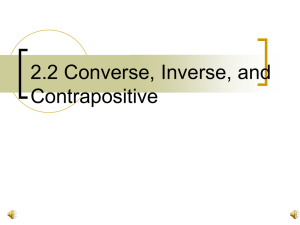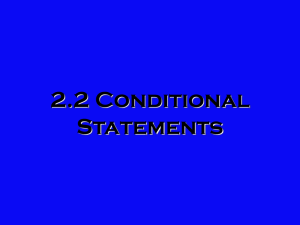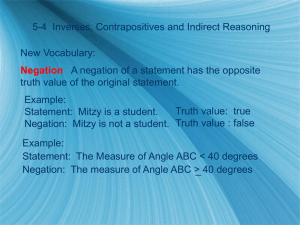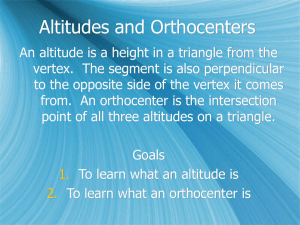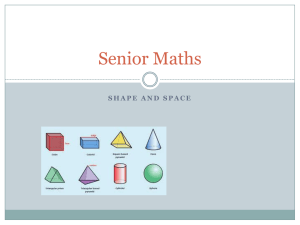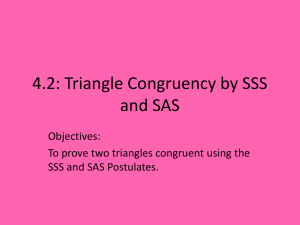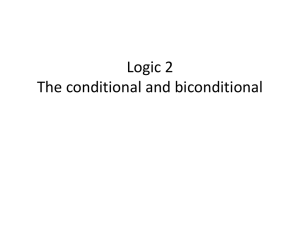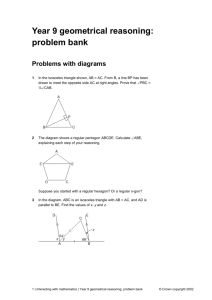Jeopardy
advertisement
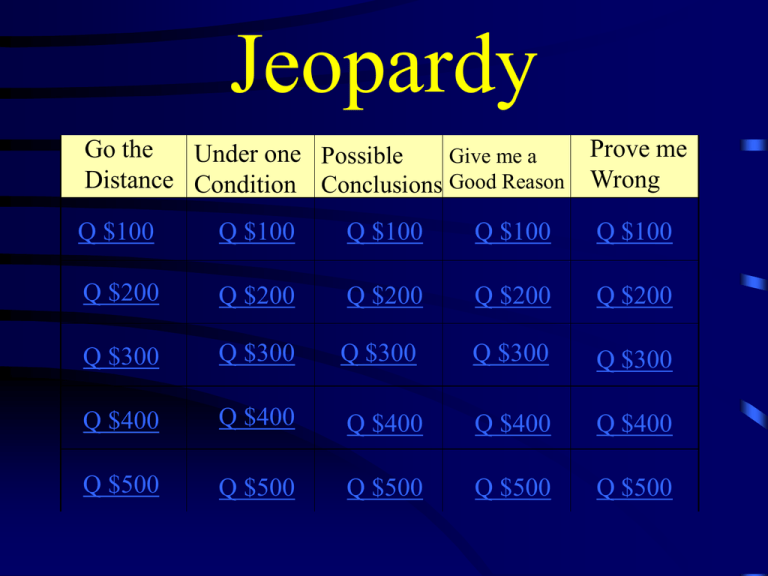
Jeopardy Prove me Go the Under one Possible Give me a Distance Condition Conclusions Good Reason Wrong Q $100 Q $100 Q $100 Q $100 Q $100 Q $200 Q $200 Q $200 Q $200 Q $200 Q $300 Q $300 Q $300 Q $300 Q $300 Q $400 Q $400 Q $400 Q $400 Q $400 Q $500 Q $500 Q $500 Q $500 Q $500 $100 Question from Go the Distance The distance formula is this. What is $200 Question from Go the Distance The distance between T(5, 2) and R(-4, -1) is this. What is 3 10 $300 Question from Go the Distance The distance between points a and d is this. What is 4 5 $400 Question from Go the Distance The midpoint between (–1, 2) and (3, –6) is this. What is M(1, -2) $500 Question from Go the Distance The missing endpoint given endpoint- (4,2) midpoint-(6,0) is this. What is (8, -2) $100 Question from Under one Condition Write the statement as a conditional: An acute angle measures less than 90 degrees. What is if an angle is acute, then it measures less than 90 degrees. $200 Question from Under one Condition What is the converse and inverse of the following statement: If ABC is equilateral, then it is isosceles. Converse: If ABC is isosceles, then it is equilateral. Inverse: If ABC is not equilateral, then it is not isosceles. $300 Question from Under one Condition Write the following statement as a conditional, and write its contrapositive. All obtuse angles have measure greater than 90. Conditional: If an angle is obtuse, then it has measure greater than 90. Contrapositive: If an angle does not have measure greater than 90, then it is not obtuse. $400 Question from Under one Condition Write the converse, inverse, and contrapositive of the following conditional. If a triangle is a right triangle, then it has a 90 degree angle. Converse: If a triangle has a 90 degree angle, then it is a right triangle. Inverse: If a triangle is not a right triangle, then it does not have a 90 degree angle. Contrapositive: If a triangle does not have a 90 degree angle, then it is not a right triangle. $500 Question from Under one Condition Write the converse, inverse, and contrapositive of the following conditional, and determine the truth value of each. If two angles have measure 90, then the angles are congruent. Converse: If two angles are congruent, then they have measure 90. Truth Value: False Inverse: If two angles do not have measure 90, then they are not congruent. Truth Value: False Contrapositive: If two angles are not congruent, then they do not have measure 90. Truth Value: False $100 Question from Possible Conclusions Consider the following conditional statement. If the conditional and it’s converse are true, write it as a biconditional. If three points are collinear, then they lie on the same line. Three points are collinear if and only if they lie on the same line. $200 Question from Possible Conclusions Test the following statement to see if it is reversible. If so, write it as a biconditional. If not, write not reversible. A triangle with two sides of equal length is an isosceles triangle. A triangle is an isosceles triangle if and only if it has two sides of equal length. $300 Question from Possible Conclusions If possible, use the Law of Detachment to draw a conclusion. If not write, not possible. If a person goes to the zoo, he or she will see animals. Kayla sees animals. Not possible. $400 Question from Possible Conclusions Use the Law of Syllogism to draw a conclusion. If a polygon is a hexagon, then the sum of its angles is 720. If the sum of the angles of a polygon is 720, then it has six sides. If a polygon is a hexagon, then it has six sides. $500 Question from Possible Conclusions Use the Law of Detachment and the Law of Syllogism to draw a conclusion. If you live in Little Rock, then you live in Arkansas. Levon lives in Little Rock. If you live in Arkansas, then you live in the 25th state to enter the Union. Levon lives in the 25th state to enter the union. $100 Question from Give me a Good Reason If 4m<QWR = 120, then _____, by the ____________ Property of Equality. What is 30, Division $200 Question from Give me a Good Reason Name the property for the step taken. AB = EF; therefore, AB + CD = EF + CD What is the Addition Property of Equality $300 Question from Give me a Good Reason Give a reason for each step. 7𝑥 − 4 = 10 7𝑥 = 14 𝑥=2 Given Addition Property of = Division Property of = $400 Question from Give me a Good Reason Justify each statement. Given: XY = 42 X 3(x + 4) Z XZ + ZY = XY 3(x + 4) + 3x = 42 3x + 12 + 3x = 42 6x + 12 = 42 6x = 30 x=5 3x Y Segment Addition Post. Substitution Prop. Of = Distributive Prop. Simplify. Subtraction Prop. Of = Division Prop. Of = $500 Question from Give me a Good Reason Solve for x. Justify each step. m< GFI = 128. a. m< GFD + m< DFI = m< GFI b. 9x – 2 + 4x = 128 c. 13x – 2 = 128 d. 13x = 130 e. x = 10 9x -2 4x Angle Add. Post. Substitution Prop. Of = Simplify. Addition Prop. Of = Division Prop. Of = $100 Question from Prove me Wrong Two angles whose sides form two pairs of opposite rays are these. What are vertical angles? $200 Question from Prove me Wrong Two pairs of congruent angles in the figure are these. B D O C A What are <DOA & < BOC; ,DOB & <AOC $300 Question from Prove me Wrong The value of x is this. 4x 𝑥 + 90 4𝑥 What is 30 $400 Question from Prove me Wrong If m < 1 = m < 3, order the steps given to prove that m < 2 = m < 4. 1 2 1. By the Angle Addition Postulate, m < 3 + m < 4 = 180. 2. Prove: m < 2 = m < 4. 3. By substitution, m < 3 + m < 2 = m < 3 + m < 4. 4. By the Angle Addition Postulate, m < 1 + m < 2 = 180. 5. Given: m < 1 = m < 3 6. m < 1 + m < 2 = m < 3 + m < 4, by the Transitive Property of =. 7. Subtract m < 3 from both sides, and you get m < 2 = m < 4. 3 4 5, 2, 4, 1, 6, 3, 7 or 5, 2, 1, 4, 6, 3, 7 $500 Question from Prove me Wrong Given: <1 and <2 are complementary. <3 and <2 are complementary. Prove: <1 ≅ <3 Statement <1 and <2 are complementary <3 and <2 are complementary <1 + <2 = 90 and <3 + <2 = 90 <1 + <2 = <3 + <2 <1 = <3 or <1 ≅ <3 Reason Given Given Definition of complementary angles Substitution Property of = Subtraction Property of =

